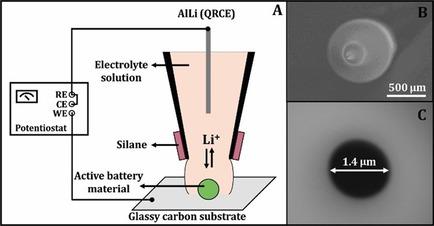当前位置:
X-MOL 学术
›
ChemElectroChem
›
论文详情
Our official English website, www.x-mol.net, welcomes your feedback! (Note: you will need to create a separate account there.)
Micropipette Contact Method to Investigate High‐Energy Cathode Materials by using an Ionic Liquid
ChemElectroChem ( IF 4 ) Pub Date : 2018-08-28 , DOI: 10.1002/celc.201800750 Malak Dayeh 1 , M. R. Zamanzad Ghavidel 1, 2 , Janine Mauzeroll 1 , Steen B. Schougaard 2
ChemElectroChem ( IF 4 ) Pub Date : 2018-08-28 , DOI: 10.1002/celc.201800750 Malak Dayeh 1 , M. R. Zamanzad Ghavidel 1, 2 , Janine Mauzeroll 1 , Steen B. Schougaard 2
Affiliation

|
The ionic liquid 1‐ethyl‐3‐methylimidazolium bis(trifluoromethylsulfonyl)imide was used in the scanning micropipette contact method to extend the electrochemical window of the electrolyte solution and enable the study of lithium‐ion battery materials with higher oxidation potential. Localized electrochemical measurements were performed on lithium iron phosphate particles that were drop‐cast onto a glassy carbon substrate. Investigation of the active materials occurred on a small scale (ca. 10 μm diameter), defined by the area of meniscus contact between the electrolyte solution in the micropipette and the substrate. Our studies showed that the SMCM probe is stable and can be used to analyze high energy lithium‐ion battery materials in the range of 2.5 to 5.1 V vs. Li/Li+.
中文翻译:

使用离子液体的微量移液器接触法研究高能阴极材料
离子液体1-乙基-3-甲基咪唑双(三氟甲基磺酰基)酰亚胺用于扫描微量移液器接触法中,以扩展电解质溶液的电化学窗口并能够研究具有较高氧化电位的锂离子电池材料。局部电化学测量是在磷酸铁锂颗粒上进行的,这些颗粒滴铸在玻璃碳基材上。活性材料的研究规模很小(直径约10μm),这是由微量移液管中的电解质溶液与底物之间的弯月面接触面积确定的。我们的研究表明,SMCM探针稳定,可用于分析相对于Li / Li +的2.5至5.1 V范围内的高能锂离子电池材料。
更新日期:2018-08-28
中文翻译:

使用离子液体的微量移液器接触法研究高能阴极材料
离子液体1-乙基-3-甲基咪唑双(三氟甲基磺酰基)酰亚胺用于扫描微量移液器接触法中,以扩展电解质溶液的电化学窗口并能够研究具有较高氧化电位的锂离子电池材料。局部电化学测量是在磷酸铁锂颗粒上进行的,这些颗粒滴铸在玻璃碳基材上。活性材料的研究规模很小(直径约10μm),这是由微量移液管中的电解质溶液与底物之间的弯月面接触面积确定的。我们的研究表明,SMCM探针稳定,可用于分析相对于Li / Li +的2.5至5.1 V范围内的高能锂离子电池材料。


























 京公网安备 11010802027423号
京公网安备 11010802027423号